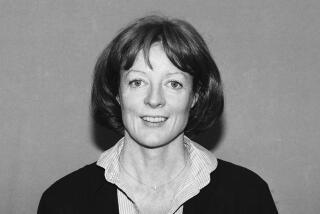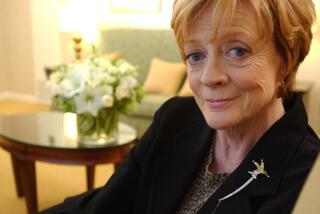Review: Matthew’s death may inject some life into ‘Downton Abbey’
Across the land, a great keening has arisen for the large number of main characters recently killed off on shows as disparate as “The Walking Dead,” “Scandal” and “Game of Thrones.” How ruthless have we become, the hand-wringers wail, how reckless and desperate in our need for tweetable moments and first-week ratings.
Honestly, it’s as if no one in this country has ever read a classic novel or a poem by Edgar Allan Poe. People die, for heaven’s sake, especially in fiction. Tragedy is a great catalyst, and even if the famous literary admonition to “kill your darlings” is impossible to trace to its origin, every gardener knows that pruning is an essential part of the job.
This is immediately and gratifyingly clear Sunday night on PBS in the Season 4 premiere of “Downton Abbey,” that highly addictive meringue of Edwardian couture and socially tolerant politics that has sentimentalized British past beyond all recognition and done more for the “special relationship” between the U.S. and Britain than any president or prime minister.
PHOTOS: The ‘Downton Abbey’ cast without costumes
Last year, in a finale that left women on two continents weeping into their “I’m a Lady Mary” T-shirts, Matthew Crawley (Dan Stevens) was killed in his motor car just moments after his wife, Lady Mary (Michelle Dockery), gave birth to their son, treating viewers to the sight of all Downton’s denizen’s rejoicing in pathetic oblivion to the tragedy that had just befallen them. Sob.
Except Matthew’s was no tragedy. Stevens took a lot of flak for choosing to leave the show, but creator Julian Fellowes should cut him a posthumous check. Never has the death of a character so obviously cleared away the brambles that can choke even a popular show to death.
Not to speak ill of the dead, but Matthew was a walking, talking deus ex machina — whenever a miracle was required, there he was, inexplicably cured of his paralysis or inheriting the funds needed to keep Downton afloat or just saying the Absolutely Right Thing.
More important, he inadvertently dimmed the lights of the show’s two most astringent, and therefore most interesting, characters: Lady Mary and Violet the Dowager Countess (Maggie Smith).
VIDEO: Interviews with the women of ‘Downton Abbey’
Who are now once again in the foreground, allowing “Downton” to return to its original themes of change and endurance.
On Season 1, “Downton Abbey” was presented as the story of two sorts of people, upstairs and down, on the cusp of cataclysm: The end of a class system that allowed places like Downton to operate along quasi-feudal lines; even improvements like the telephone and typewriter were perceived as a threat.
As the accidental heir to Downton, Matthew arrived in the hallowed halls reluctantly, a dismissive embodiment of the modern age. He worked for a living, disdained the old ways and so the obvious solution — that he should marry Mary to keep Downton in the family — was seen by both sides as a necessary evil.
Love, of course, changed all that, and by Season 2 the show had dissolved into a sugary tea of great costumes, gleaming interiors and a Kate-Middleton-infused view of Britain. Mary loved Matthew, Matthew loved Downton, the servants were treated as family and no one suffered from anything resembling social stricture. The biggest irritation seemed to be the need to dress for dinner.
With its admirable attention to accoutrement and remarkably fine cast, including the trio of unlikely male hotties (Hugh Bonneville’s Earl of Grantham; Jim Carter’s butler, Mr. Carson; and Brendan Coyle’s valet, John Bates), “Downton Abbey” allows its audience a pleasant dalliance with history — all the fun and little of the consequence. What little of its original shape remained was thanks almost completely to Lady Mary and the Dowager Countess, who, along with Mr. Carson, have refused to bend completely to the changing times.
PHOTOS: Behind the scenes of movies and TV
Now, with Matthew gone, Lady Mary and Violet are once again allowed to shine, as women who will not be rushed from one thing to another, possibly because they know only too well how difficult it is for women to find a foothold in any household, in any era.
There are, of course, many plots and subplots roiling throughout Season 4, some of which are subtle and affecting (Matthew’s mother, Isobel [Penelope Wilton] and his valet, Molesley [Kevin Doyle], are both looking for a job), some of which seem more strained than usual (Lady Rose [Lily James] seems to wander briefly over into the new Starz show “Dancing on the Edge”). The ever-popular Bates’ marriage undergoes yet another tremendous strain, and Lady Edith (Laura Carmichael) continues a very odd affair with her editor (never a good idea, Lady Edith!) that may turn out fascinating or ridiculous.
Nonetheless, all eyes are on Mary, who, having shed her shell for Matthew, is nearly catatonic with grief even six months after his death. Working to stir her into taking an interest in the running of the estate is chauffeur turned brother-in-law Tom (Allen Leech), who has “what next?” issues of his own and, more important, the Dowager Countess, a woman who has survived more change than all of the other characters combined and whom Smith continues to infuse with the potent grace of Considered Transformation.
Which is so much more interesting than its flighty cousin, Miraculous Transformation, so favored these days by even those wailing over the unlit pyres of the fictitious dead.
When Fellowes allows his characters to show that mettle and strength are not necessarily the prettiest things in the room, “Downton” transcends its soap bubbles and more than earns its histrionic plot twists.
When Violet goes, however, all bets are off.
Twitter: @marymacTV
More to Read
The complete guide to home viewing
Get Screen Gab for everything about the TV shows and streaming movies everyone’s talking about.
You may occasionally receive promotional content from the Los Angeles Times.







